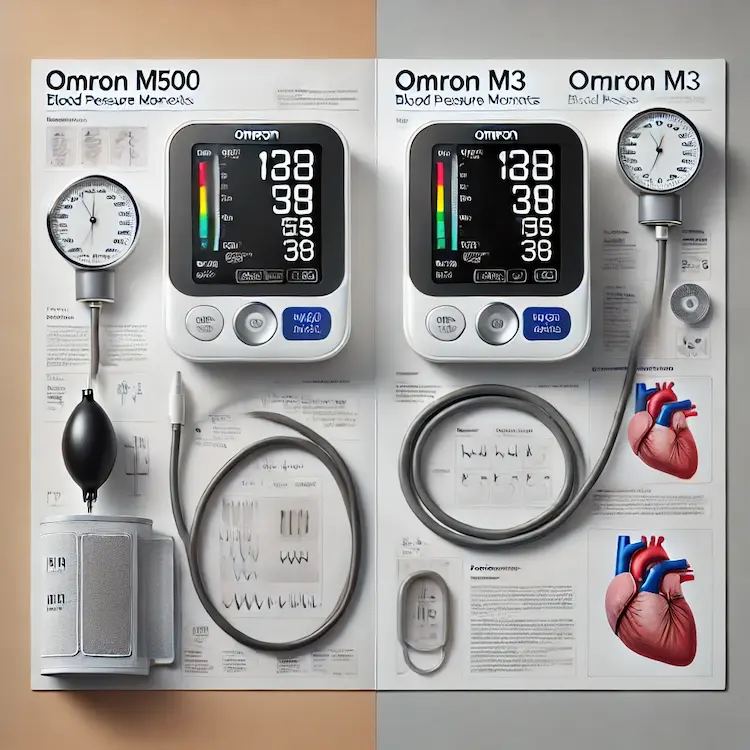High blood pressure (hypertension) is a major global health concern, affecting over 1.28 billion adults worldwide, according to the World Health Organization (WHO). Early detection and accurate blood pressure monitoring are critical for effective management and prevention of cardiovascular diseases, strokes, and kidney failure. With the increasing reliance on home blood pressure monitors, selecting a highly accurate device — such as the Omron M500 vs Omron M3 — can make a significant difference in personal health outcomes. This article offers an in-depth comparison of Omron M500 vs Omron M3, focusing specifically on their accuracy in detecting high blood pressure.
Both the Omron M500 vs Omron M3 are popular upper-arm blood pressure monitors used by healthcare professionals and individuals at home. While both models meet basic accuracy standards, they differ in terms of features, validation protocols, and technology — all of which can impact their reliability in detecting hypertension. This article breaks down these differences into easily digestible sections, backed by relevant facts, practical advice, and visual comparisons.
Importance of Accurate High Blood Pressure Detection
Health Impacts
Accurate detection of hypertension allows for timely intervention, which can:
- Prevent cardiovascular diseases.
- Reduce the risk of stroke.
- Prevent kidney failure and related complications.
- Support lifestyle changes by providing reliable data for adjustments.
Societal Impacts
Inaccurate blood pressure readings can lead to:
- Overdiagnosis or underdiagnosis of hypertension.
- Unnecessary medication use or missed treatment opportunities.
- Increased healthcare costs from mismanaged conditions.
- Strain on healthcare systems from preventable complications.

Omron M500 vs. Omron M3: Overview and Specifications
| Feature | Omron M500 | Omron M3 |
|---|---|---|
| Cuff Type | Intelli Wrap Cuff (360° accuracy) | Standard Cuff |
| Validation | Clinically validated (including for pregnancy and diabetes) | Clinically validated |
| Detection Capabilities | Irregular heartbeat, morning hypertension, and triple measurement | Irregular heartbeat |
| Data Storage | 2 users, 100 readings each | 2 users, 60 readings each |
| Smart Features | Hypertension indicator, advanced averaging | Basic averaging only |
| Accuracy-Enhancing Tech | Intelli Wrap + Advanced Accuracy algorithm | Standard Omron algorithm |
| Price Range | Moderate-High | Budget-Mid |
Comparative Analysis: Accuracy in High Blood Pressure Detection
1. Intelli Wrap Cuff vs. Standard Cuff
Omron M500 features the Intelli Wrap Cuff, which provides consistent accuracy regardless of how the cuff is placed on the arm. This 360° design eliminates positioning errors, which are common with standard cuffs like the Omron M3’s. According to Omron’s clinical trials, the Intelli Wrap Cuff reduces errors by up to 30% compared to traditional cuffs, improving high blood pressure detection reliability.
2. Advanced Averaging vs. Basic Averaging
Omron M500 uses an advanced averaging algorithm, automatically averaging three consecutive readings for more accurate results. This feature is crucial for identifying subtle blood pressure spikes, particularly in the morning — a key period when hypertension risks are higher.
Omron M3 offers basic averaging, typically over two readings, which is less comprehensive in detecting fluctuations associated with morning hypertension.
3. Morning Hypertension Detection
Morning hypertension (elevated morning blood pressure) is associated with higher cardiovascular risks. The M500 includes a dedicated morning hypertension indicator, which alerts users if their morning readings exceed safe thresholds.
Omron M3 lacks this dedicated feature, limiting its effectiveness in capturing these critical spikes.
4. Clinical Validation and Special Populations
Both devices are clinically validated, but the Omron M500 undergoes additional testing for special populations, including pregnant women and diabetics — two groups at elevated risk for high blood pressure complications. This broader validation boosts confidence in its accuracy for diverse users.
5. Irregular Heartbeat Detection
Both monitors detect irregular heartbeats, but the M500 provides more context by integrating this data into overall readings, offering users better insight into potential arrhythmias contributing to high readings.
Statistical Context: Accuracy Impact on Hypertension Management
- Studies show that home blood pressure monitors with position-independent cuffs (like Intelli Wrap) reduce measurement errors by up to 30% (Source: European Society of Hypertension).
- Between 5% and 15% of home blood pressure monitors provide readings that deviate by more than 10 mmHg from clinical-grade devices (Source: Journal of Hypertension).
- Accurate early detection combined with lifestyle changes can lower the risk of heart attack by up to 25% (American Heart Association).

Practical Tips for Accurate Home Monitoring
- Use validated devices. Choose devices like Omron M500 or M3 with clinical validation.
- Ensure correct cuff placement. Intelli Wrap Cuff reduces this concern, but standard cuffs require precise positioning.
- Measure at consistent times. Morning and evening readings offer the best long-term picture.
- Relax before measuring. Sit quietly for 5 minutes before taking a reading.
- Keep a log. Track readings over weeks to spot trends.
- Monitor irregular heartbeats. Consult your doctor if you consistently detect arrhythmias.
Visual Aid: Comparative Accuracy Factors
| Factor | Omron M500 | Omron M3 |
|---|---|---|
| Cuff Technology | Intelli Wrap (360°) | Standard |
| Special Population Validation | Yes | No |
| Multi-Reading Averaging | Advanced (3 readings) | Basic (2 readings) |
| Morning Hypertension Indicator | Yes | No |
| Irregular Heartbeat Alerts | Enhanced (contextual) | Basic |
Conclusion
In the comparison of Omron M500 vs. Omron M3, the M500 emerges as the more accurate device for high blood pressure detection. This advantage stems from its Intelli Wrap Cuff, advanced averaging algorithms, and morning hypertension detection capabilities. While the Omron M3 remains a reliable entry-level device, individuals at higher cardiovascular risk or those managing complex conditions (like diabetes or pregnancy) benefit more from the M500’s precision and enhanced features.
Key Takeaways:
- Accuracy is crucial for effective hypertension management and cardiovascular risk reduction.
- Omron M500 offers superior accuracy, especially for users with higher risks.
- Omron M3 remains a good choice for basic monitoring in otherwise healthy individuals.
- Proper cuff placement, regular readings, and long-term trend tracking enhance accuracy.
Actionable Recommendations:
- Choose the right device for your risk profile. Higher-risk users benefit more from M500’s advanced features.
- Use a consistent measurement routine. Same time, same posture, same arm.
- Review readings with your doctor regularly.
- Consider devices with enhanced detection features (like M500) if you have irregular heartbeats or morning hypertension risk.


